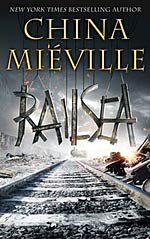
![]() mellyn
mellyn
6/21/2013
![]()
Reading China Mieville is always somewhat of an adventure. Not only is his vocbulary extensive, but his novels are always unpredictable. I never know what what to expect when opening one up. Having heard that Railsea was his take at Young Adult, I was interested to see the results.
Mieville likes to tweak expectation. Railsea is set in a dystopian and diseased world, and uses traditionally nautical imagery and phrases in reference to the world's railways. Main character Sham Yes ap Soorap is a young man who has recently joined Captain Naphi's Medes, a moletrain, as the doctor's apprentice. Sham isn't very good at his job, with Dr Fremlo's opinion quite clearly stated: "You may not like it, you may not be very good at it - you are not, in fact, very good at it, & if I can tell that, that means you are very not good at it - but you are probably somewhat better than nothing." Sham really pines for salvage, but the career of a salvor was not something his guardians considered suitable.
Captain Naphi steers the course of the moletrain. While the train hunts, Naphi's real object is to meet her philosophy: an ivory moldywarpe that took her arm. Whenever in town, or when they meet another train on the railsea, her first question is whether her quarry has been sighted. More often than not, the answer is no.
During Sham's first trip on the railsea, the Medes encounters a wreck. Molers are not permitted to salvage wrecks, but it is expected that they assist survivors. The Medes stops, and Shem manages to talk his way on to the crew moving aboard the wreck. While there, he finds an item hidden in the dirt: a memory card from a camera. Naphi soon confiscates the memory from Shem, much to his disappointment. Luckily for him, however, she allows him to view the pictures during their next stop in town. Two images specifically speak to him: one of two children below an arch, and another that completely blows his mind - flat ground off to the horizon with only one single rail through the middle. After viewing the pictures, Nephi destroys the card.
Being an orphan himself, Sham feels a need to find the children to tell them the fate of their loved one. He does not know what happened to his own parents, and wishes there were someone out there able to do the same for him. He also wonders about the second photo, about what a place without rails truly represents. However Nephi has no interest in being distracted from her quarry, with Sham's interests all off in very different directions to the interests of moletrains.
In some ways Railsea is very Mieville. I could definitely see his fingerprints all over the novel. It isn't what I would consider a 'typical' young adult novel, and as with all Mieville's stuff, I don't think it would appeal to everybody. It is still quite conceptual, weird, and uses lot of weird and wonderful words. And, of course, being Mieville, there's some politics in there as well. But I do think it is a little more... accessible, perhaps than most of Mieville's novels.
One thing that grated was that there is not one single 'and' throughout the novel. Mieville uses "&" as a stylistic choice, one that he explains at one point, in the context of the world. I get the point that he was making, but... I find it a bit jarring to read, especially at the beginning of sentences.
Overall, though, I found it a really good read. The characters were well built and believable, the world was well defined and explained. I thought the ending worked for the most part, and Mieville didn't lose his voice writing for a different audience.
I would highly recommend it, and am quite looking forward to whichever Mieville novel I happen to pick up next.
http://books.mellyn.net/node/20